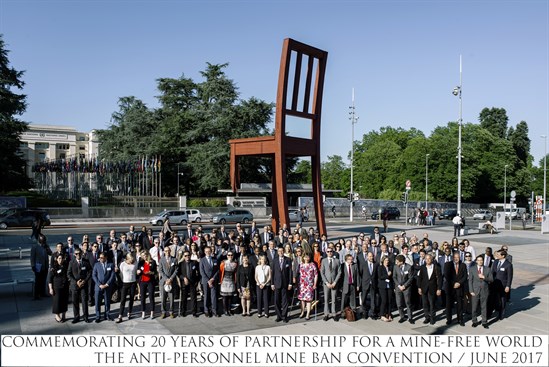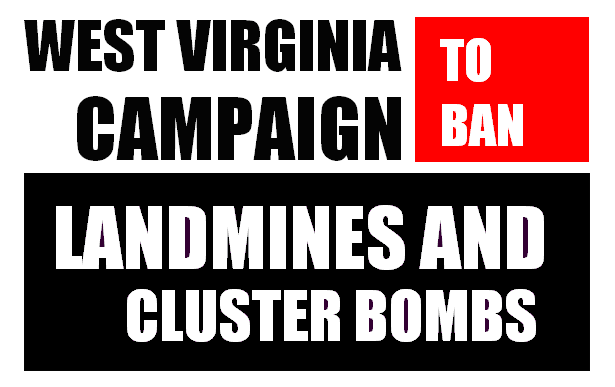
On 18 September 1997, nations from around the world came together in Oslo to adopt the Mine Ban Treaty. On December 4th, 1997, the Mine Ban Treaty was signed in Ottawa. This year, we celebrate the 20th anniversary of the treaty!
Banning landmines would have not been possible without great partnerships among civil society and governments. As Archbishop Desmond Tutu once said “if the Mine Ban Treaty has made a difference in the world, it is because the partnership between governments and civil society forged through the process that created the treaty has continued to this day”. Since its inception in 1992, the ICBL— representing hundreds of NGOs, landmine survivors, mine action operators and experts — has been working closely with governments and other actors to achieve a mine-free world.
The adoption of the treaty 20 years ago was a milestone start to an end of suffering caused by landmines. To date, the Mine Ban Treaty has been at the heart of many achievements.
More than 80 per cent of the world’s countries outlawed landmines by joining the treaty. The stigma against landmines has grown strong. Landmine trade is virtually eliminated. Sixty-five (65) non-state armed groups have pledged not to use landmines. At least 39 states that once produced landmines have stopped producing them. Twenty-seven (27) countries finished clearing and destroying landmines. More than fifty-one (51) million stockpiled landmines have been destroyed. New landmine casualties have been dramatically reduced from the 40-55 people a day that were killed or injured in the 1990s. The rights of landmine victims have been increasingly recognized.
But millions of people are still threatened by landmines and unexploded bombs worldwide and on-going conflicts in Syria, Iraq and elsewhere have created a new ‘landmine emergency’. Meanwhile development opportunities and food security in countries such as Angola, Cambodia and Zimbabwe are being undermined by millions of mines left over from conflicts that ended decades ago.States party to the Ottawa Treaty have set a deadline of 2025 to clear remaining mine contamination. After 20 years of success we have a lot to celebrate, but the work is not done. JOIN US AS WE DEDICATE OURSELVES TO THIS WORK!
Mine Ban Treaty: Facts, achievements and challenges
- The Mine Ban Treaty was the first international treaty to ban a weapon of war that had been in widespread use.
- Thanks to pressure created by civil society the treaty did not allow for any loopholes, exceptions or reservations.
- The Mine Ban Treaty was highly unusual in being both a humanitarian and a disarmament treaty. It was the first international treaty to include provisions for victims of the weapon along the provisions related to the use, production, transfer and stockpiling of the weapon itself.
- The Ottawa Process was so successful in quickly achieving its aims that this process has been used as a model for other lifesaving movements – such as the Oslo Process to ban cluster bombs and the campaign to stop the use of child soldiers and most recently, nuclear weapons.
- Achievements: 80% of the world has joined the Treaty. The stigma on antipersonnel mines holds firm. Over the past 20 years since the Treaty’s adoption there has been a dramatic decrease in worldwide use, production, and transfer of antipersonnel mines, the number of casualties reported annually has been massively reduced since the campaign began; more than 51 million mines in stockpiles have been destroyed; large tracts of land have been cleared and 26 states have been declared mine-free. Crucially, any use of antipersonnel landmines is also today widely recognized as being unacceptable, and is resoundingly condemned.
- States Parties to the Mine Ban Treaty have embraced an aspirational deadline of 2025 to complete their treaty obligations.
- Based on these achievements, we know a world without landmines is possible, but the international community must remain fully committed to this goal and continue to work diligently to achieve this by 2025.
- Challenges: 35 states, including the United States, still remain outside of the Treaty and instances of new landmine use, though rare, are reported every year. Some 6,000 people are reported to be maimed or killed by these weapons every year. Some 60 countries and territories remain affected by landmines. Assistance and services for landmine victims are scarce and insufficient in the majority of affected countries.
- Therefore, there is a clear need for all states to join the Mine Ban Treaty and to work hard to fully implement it.
The International Campaign to Ban Landmines: History and achievements
- The ICBL’s global civil society movement created a legal and diplomatic precedent that placed humanitarian values above military needs and saved countless lives: we made sure this ban was focused on protecting people, rather than military needs.
- The ICBL is shaped by its hundreds of members in close to one hundred countries.
- From the beginning, the ICBL’s strength has been rooted in hundreds of civil society organizations (like PSALM) from a vast and diverse range of backgrounds being united under one goal and message: to ban landmines.
- Driven by the voices of survivors, the ICBL used its technical, legal and political expertise to play a major role in drafting the Mine Ban Treaty from the start of the Ottawa Process that led to adoption of the MBT.
- The ICBL, along with the ICRC were considered vital partners in the process and included in all the diplomatic meetings leading up to the Treaty negotiations, and during negotiations themselves. The critical importance of the presence and input of the ICBL and the ICRC was specifically recognized in the preamble of the Treaty.
- The role played by the ICBL in the Ottawa Process was recognized by the Nobel Committee in December 1997 which granted ICBL and its Coordinator the Nobel Peace Prize for changing ‘a ban on antipersonnel mines from a vision to a feasible reality’ (quote from the Nobel Committee).
- After the treaty’s entry into force, the ICBL established an unprecedented independent civil society-based systematic monitoring and reporting regime on universalization and implementation of the treaty – the Landmine Monitor, which has been issued every year since 1999.
- The ICBL has spent 25 years campaigning for a mine-free world and has seen how far the world has come towards reaching this goal.
